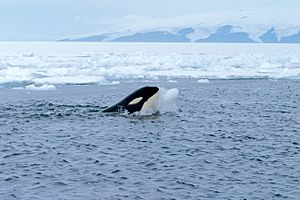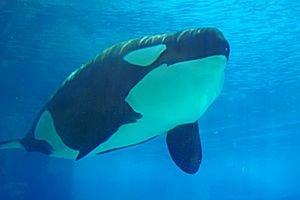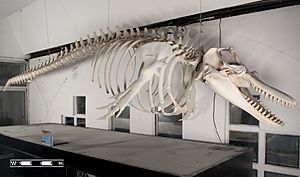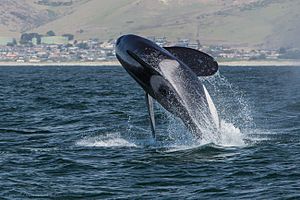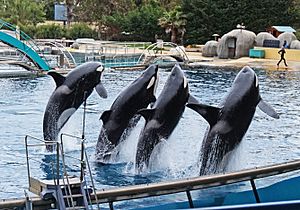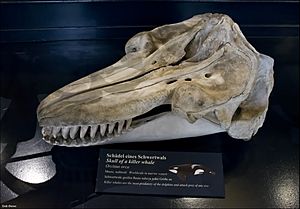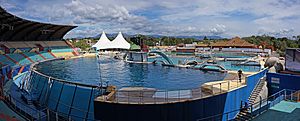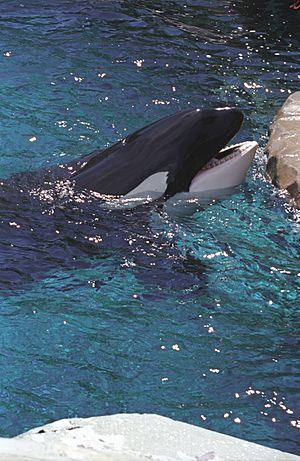Killer whale facts for kids
Quick facts for kids Killer whaleOrca |
|
|---|---|
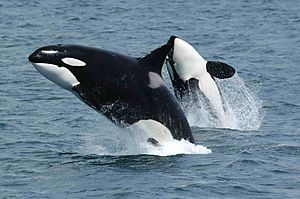 |
|
| Orcas jumping near Unimak Island, Alaska | |
 |
|
| Size compared to a 1.80 meter human | |
| Conservation status | |
| Scientific classification | |
| Genus: |
Orcinus
|
| Species: |
orca
|
 |
|
| Orcinus orca range | |
| Synonyms | |
|
|
Killer whales, also known as Orcas (Orcinus orca), are the biggest members of the dolphin family. They are called 'whales' because of their large size. Orcas are easy to spot with their unique black and white coloring.
You can find killer whales in every ocean around the world. They live in cold places like the Arctic and warm places near the Tropics. The only seas they usually avoid are the Baltic Sea and Black Sea, and some parts of the Arctic Ocean.
Some groups of killer whales are in danger. This is because their food sources are shrinking, their homes are being destroyed, and pollution is a problem. Also, some are captured for marine mammal parks, and they can have problems with human fishing. For example, in 2005, the killer whales living near British Columbia and Washington state were added to the U.S. Endangered Species list.
Wild killer whales are not known to harm humans. However, there have been rare cases where captive orcas have injured or even killed their trainers at marine parks.
Contents
How Smart Are Killer Whales?
Killer whales have the second-largest brains among all marine mammals. They can learn tricks when they are in captivity. Many people describe them as very intelligent. But it's hard to truly measure how smart they are, since their lives are so different from ours.
Orcas learn by watching others and seem to teach their young. A great example is how they catch seals. In places like Valdés Peninsula, adult orcas sometimes push seals onto the beach. Then, they let the seals go near younger whales. This allows the young whales to practice catching the seals, which is a tricky skill.
Near the Crozet Islands, mother orcas even push their babies onto the beach. They wait nearby to pull them back if needed.
People who spend time with killer whales often share stories about how curious and playful they are. They also show great problem-solving skills. For instance, killer whales in Alaska learned how to take fish from fishing lines. They even figured out ways around different methods used to stop them.
The way killer whales use special sounds (like dialects) and pass on learned behaviors to their young is sometimes called a form of culture.
What Do Killer Whales Look Like?
Killer whales are the largest members of the dolphin family alive today. Male orcas are usually about 6 to 8 meters (20 to 26 feet) long. They can weigh more than 6,000 kilograms (13,000 pounds). Females are smaller, typically 5 to 7 meters (16 to 23 feet) long and weighing about 3,000 to 4,000 kilograms (6,600 to 8,800 pounds).
A typical killer whale has a black back and white chest and sides. They also have a clear white patch above and behind each eye.
The dorsal fin, which is the fin on their back, can be up to 1.8 meters (6 feet) tall. This is taller than most adult humans! Since killer whales swim near the surface, their dorsal fin is often seen gliding through the water. This sometimes makes people mistake them for sharks.
In captivity, the dorsal fins of killer whales often collapse. This happens for many reasons. But in the wild, less than one percent of orcas have a collapsed dorsal fin.
Killer whales have very strong teeth and powerful jaws. Their upper teeth fit perfectly into the gaps between their lower teeth when their mouth is closed. The teeth in the middle and back of their mouth hold prey firmly. The front teeth point slightly forward to protect them from strong movements when they catch food. Orcas have good eyesight both in and out of the water. They also have excellent hearing and a good sense of touch.
Sometimes, a killer whale can be completely white. These rare white orcas have been seen in the northern Bering Sea, near St. Lawrence Island, and off the coast of Russia. In 2008, a white killer whale was photographed near Kanaga Island in the Aleutian Islands.
What Do Killer Whales Eat?
Killer whales are apex predators. This means they are at the top of the food chain and have no natural enemies. They are sometimes called the "wolves of the sea" because they hunt in groups, much like wolf packs.
Killer whales eat a wide variety of prey. This includes fish, cephalopods (like squid), marine mammals (like seals and sea lions), sea birds, and sea turtles.
Different groups of orcas might specialize in hunting certain types of food. This can have a big impact on the populations of the animals they hunt. However, orcas in warmer, tropical areas tend to eat a wider range of foods because there is less food available overall.
Killer Whale Behavior
Killer whales spend their days doing things like looking for food, traveling, resting, and playing together. They often do cool things on the surface of the water. This includes breaching (jumping completely out of the water) and tail-slapping. These actions might be for showing off, talking to each other, getting rid of parasites, or just for fun. Spyhopping is when a whale holds its head out of the water to look around.
Orcas are known for their complex social lives. Only animals like elephants and higher primates (like monkeys and apes) have social groups that are as complex. Because of these strong social bonds, many marine experts worry about keeping orcas in captivity. They question if it's fair to these highly social animals.
Orcas and Humans
Female killer whales can often be trained to perform tricks for audiences at marine shows, like those at Sea World. Killer whales have even been movie stars, such as in the film Free Willy.
While wild orcas are not dangerous to humans, captive orcas have been known to injure or even kill their trainers on rare occasions. Because of this, some marine parks now require trainers to stay out of the water when working with orcas. Since the 1970s, captive killer whales have been involved in nearly two dozen attacks on humans, some of which were deadly.
Killer Whales in Culture
The indigenous peoples of the Pacific Northwest Coast have many stories and artworks featuring killer whales. They are important in their history, spirituality, and religion. The Haida believed killer whales were the most powerful animals in the ocean. Their myths tell of orcas living in underwater houses and towns.
For the Kwakwaka'wakw people, the killer whale was seen as the ruler of the undersea world. They believed orcas had sea lions as slaves and dolphins as warriors. The Tlingit people of southeastern Alaska thought of the killer whale as a protector of the sea and a helper for humans. The ancient Maritime Archaic people of Newfoundland also deeply respected killer whales. This is shown by stone carvings found in a 4,000-year-old burial site.
How Long Do Killer Whales Live?

In the wild, female killer whales usually live for 50 to 80 years. Some researchers believed one female, named Granny (J2), lived to be as old as 105 years. However, later tests suggested she was closer to 65 to 80 years old. It is thought that orcas kept in captivity often live shorter lives than those in the wild. But scientists still debate this topic.
Wild male orcas live about 29 years on average, with a maximum age of around 60 years. There was a male orca known as Old Tom. He was reportedly seen every winter from the 1840s to the 1930s off New South Wales, Australia. If true, he would have been up to 90 years old. However, examining his teeth suggested he died around age 35. This method of telling age is now thought to be less accurate for older animals. Another male, known as J1, was estimated to be 59 years old when he died in 2010.
Orcas are special among cetaceans (whales and dolphins). As they get older, their tail sections grow longer, making their heads seem shorter in comparison.
How Many Killer Whales Are There?
It's hard to know exactly how many killer whales there are worldwide. But experts believe there are at least 50,000 (as of 2006).
Here are some estimated numbers for different areas:
- About 25,000 in the Antarctic.
- Around 8,500 in the tropical Pacific Ocean.
- Between 2,250 and 2,700 off the cooler northeast Pacific.
- About 500 to 1,500 off Norway.
- Japan's Fisheries Agency estimated around 2,321 orcas in the seas around Japan in the 2000s.
Killer Whales in Captivity
Killer whales are very smart, can be trained, look striking, and are playful in captivity. Their large size has made them popular attractions at aquariums and marine mammal parks. Between 1976 and 1997, 55 whales were taken from the wild in Iceland, 19 from Japan, and three from Argentina. These numbers do not include animals that died during capture.
Live captures dropped a lot in the 1990s. By 1999, about 40% of the 48 orcas on display around the world were born in captivity.
Groups like World Animal Protection and the Whale and Dolphin Conservation work against keeping orcas in captivity. They point out that captive orcas often develop health problems. For example, 60–90% of captive male orcas have a collapsed dorsal fin. Also, captive orcas often live much shorter lives.
Life in captivity is usually very different from their natural home. The social groups of captive whales are also not like those found in the wild. Critics say that captive life is stressful for these reasons. They also say that being forced to perform circus tricks, which are not natural behaviors, adds to the stress. Wild killer whales can travel up to 160 kilometers (100 miles) in a day. Critics argue that these animals are too big and too smart to be kept in small tanks.
Captive orcas sometimes act aggressively towards themselves, other whales in their tank, or humans. Critics believe this is a result of stress.
Between 1991 and 2010, a male orca named Tilikum was involved in the deaths of three people. He was featured in the well-known 2013 film, Blackfish. Tilikum lived at SeaWorld from 1992 until he died in 2017.
In March 2016, SeaWorld announced that they would stop their orca breeding program. They also said they would end their theatrical shows. They had previously announced this for San Diego in November 2015, but then extended it to Orlando and San Antonio as well.
See also
 In Spanish: Orca para niños
In Spanish: Orca para niños
Images for kids
-
Orca beaching to capture sea lion at Valdes Peninsula
-
A pair of orcas in the Pacific Northwest
-
Male orca depicted in St Mary's in Greifswald, Germany, 1545
-
Lolita, at the Miami Seaquarium, is one of the oldest whales in captivity.



